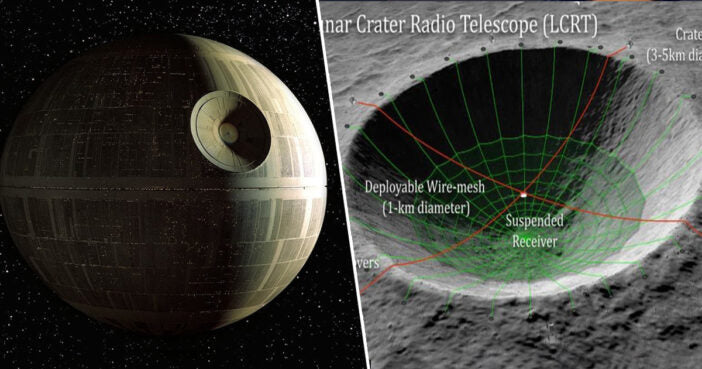
NASA's "Not The Deathstar" Telescope Is Possibly Cooler Than Deathstar...
Share
The far side of the moon is a mysterious little bit of space, what with its fabled history interlaced with our popular culture and long-time fascination embedded in Sci-Fi films.
Perhaps it was from this fascination the concept was conceived, but either way you look at it, NASA wants to build a huge radio telescope within a crater on the far side of the moon.
The project is known as the Lunar Crater Radio Telescope (LCRT) fathered by Saptarshi Bandyopadhyay, a robotics tech within NASA's Jet Propulsion Laboratory, and the name could not be less exciting. Even though the far-reaching implications of the telescope are exactly the opposite.
But, why the far side of the moon?
It faces away from Earth and never gets the noisy pollution of our constant radio signals from us as well as being shielded from Earth's ionosphere, its satellites, and the Sun's massive radio interference.
NASA is so keen, they've just greenlighted a funding proposal to build the dish-shaped "...largest filled-aperture radio telescope in the solar system," sayeth NASA's Bandyopadhyay in his conceptual abstract. Phase 1 funding of US$125,000 from NASA Innovative Advanced Concepts (NIAC) has been awarded to the LCRT project and although it is in the early stages, it looks very promising.

The strengths of having an ultra-long wavelength radio telescope on the far side of the moon are quite remarkable, such as more exploration of the universe at wavelengths greater than 10m - or frequencies below 30MHz - that are usually reflected by Earth's ionosphere and are not actively pursued by us as a result.
The satellite aims to be housed in a whopping 3-5km diameter crater and from a 1km colossal spherical-cap reflector, the largest filled-aperture radio telescope in the solar system, or so NASA says (aliens?). This means the telescope uses the singular large dish to receive radio data instead of radio arrays which are made of many dishes networked together and are far slower.
The current largest filled-aperture telescope is the Chinese Five-hundred-meter Aperture Spherical radio Telescope (FAST) which is only half of the proposed size of the LCRT. This also means that while the LCRT is double the size, it is also twice as fast at collecting radio data.
The unique way they're setting up the wire mesh within the crater is via droid looking lander rovers via the process below.

The next steps include finding the perfect crater candidate and tweaking the performance of the mechanical design concepts. There is also the added pressure of competing against fellow concepts for where to assign NASA funding. Just this past week, NASA also granted Phase 1 funding to more than 12 other projects including agile gravity hopping bots used in exploring celestial bodies and an antimatter system potentially used as brakes during interstellar travel.
We're hoping the telescope makes it past phase 3 and assembly is streamed live as it happens so we can see these little guys in action. Thanks to their efforts, we could see well into the early universe in the range of 6-30MHz which has never been explored by humans to date. Mysteries from 13 billion years ago could come to light as well as more sensitive data such as details of exoplanets that orbit stars much like Earth.
Every time the telescope is in use it will show us something never before revealed to humankind. How exciting!
Thanks for reading and remember to click below to support us as we thrust into the deep unknown...
#Space_Aus




